TOYOTA iA 2016 Owners Manual (in English)
Manufacturer: TOYOTA, Model Year: 2016, Model line: iA, Model: TOYOTA iA 2016Pages: 588, PDF Size: 5.15 MB
Page 211 of 588
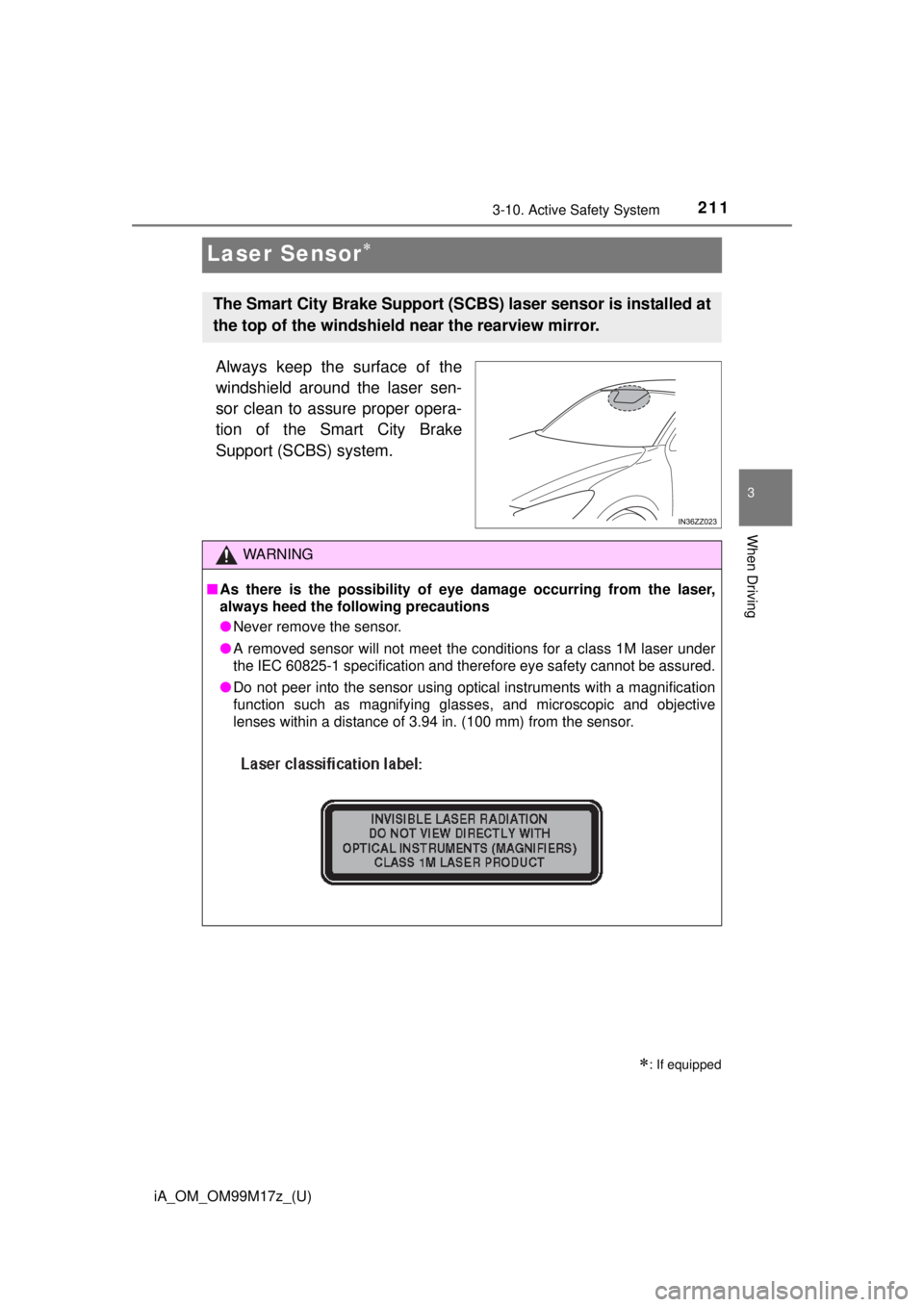
211
iA_OM_OM99M17z_(U)
3-10. Active Safety System
3
When Driving
Laser Sensor
Always keep the surface of the
windshield around the laser sen-
sor clean to assure proper opera-
tion of the Smart City Brake
Support (SCBS) system.
: If equipped
The Smart City Brake Support (SCBS) laser sensor is installed at
the top of the windshield near the rearview mirror.
WARNING
■As there is the possibility of eye damage occurring from the laser,
always heed the following precautions
● Never remove the sensor.
● A removed sensor will not meet the conditions for a class 1M laser under
the IEC 60825-1 specification and therefore eye safety cannot be assured.
● Do not peer into the sensor using optical instruments with a magnification
function such as magnifying glasses, and microscopic and objective
lenses within a distance of 3.94 in. (100 mm) from the sensor.
Page 212 of 588
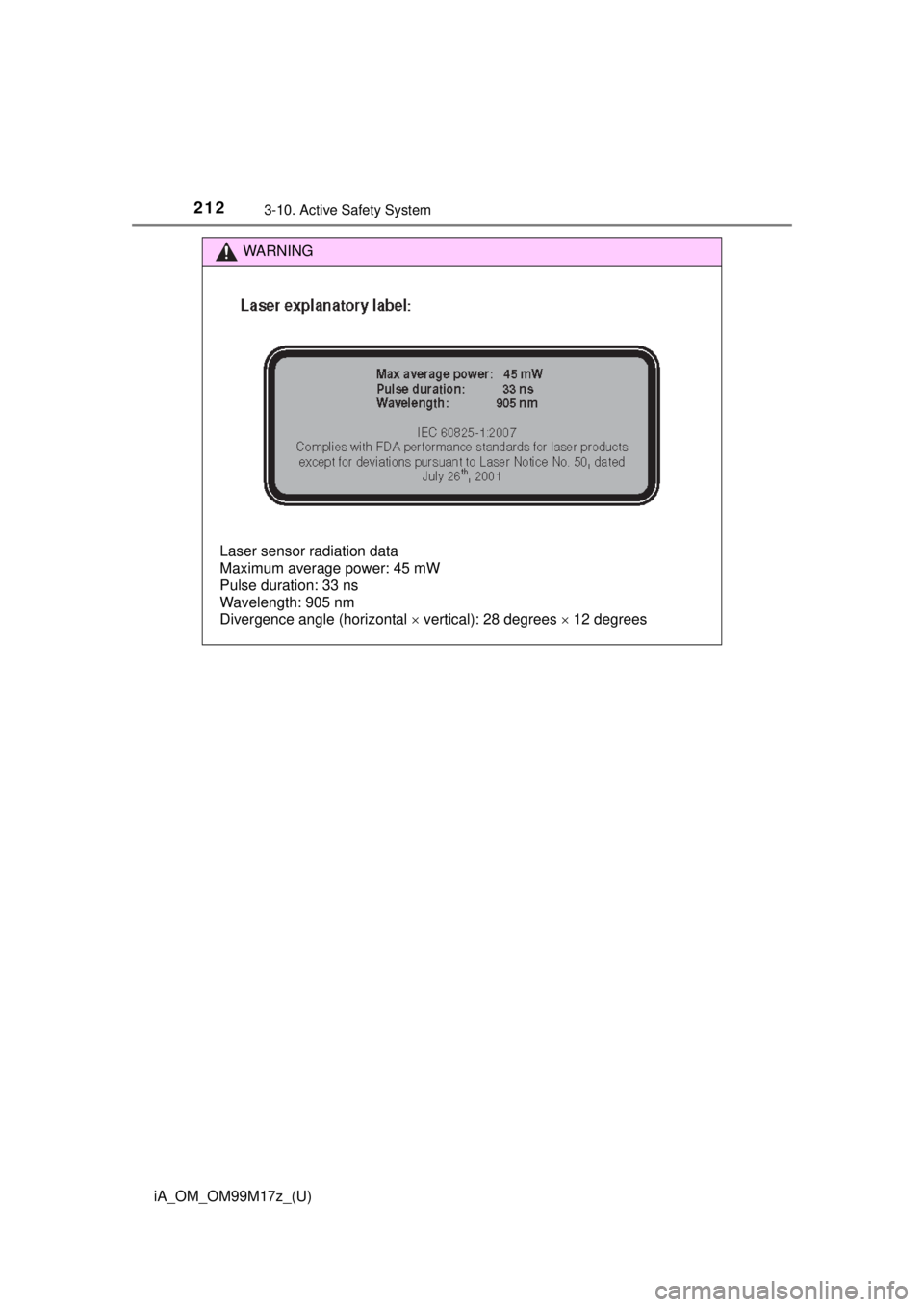
212
iA_OM_OM99M17z_(U)
3-10. Active Safety System
WARNING
Laser sensor radiation data
Maximum average power: 45 mW
Pulse duration: 33 ns
Wavelength: 905 nm
Divergence angle (horizontal vertical): 28 degrees 12 degrees
Page 213 of 588
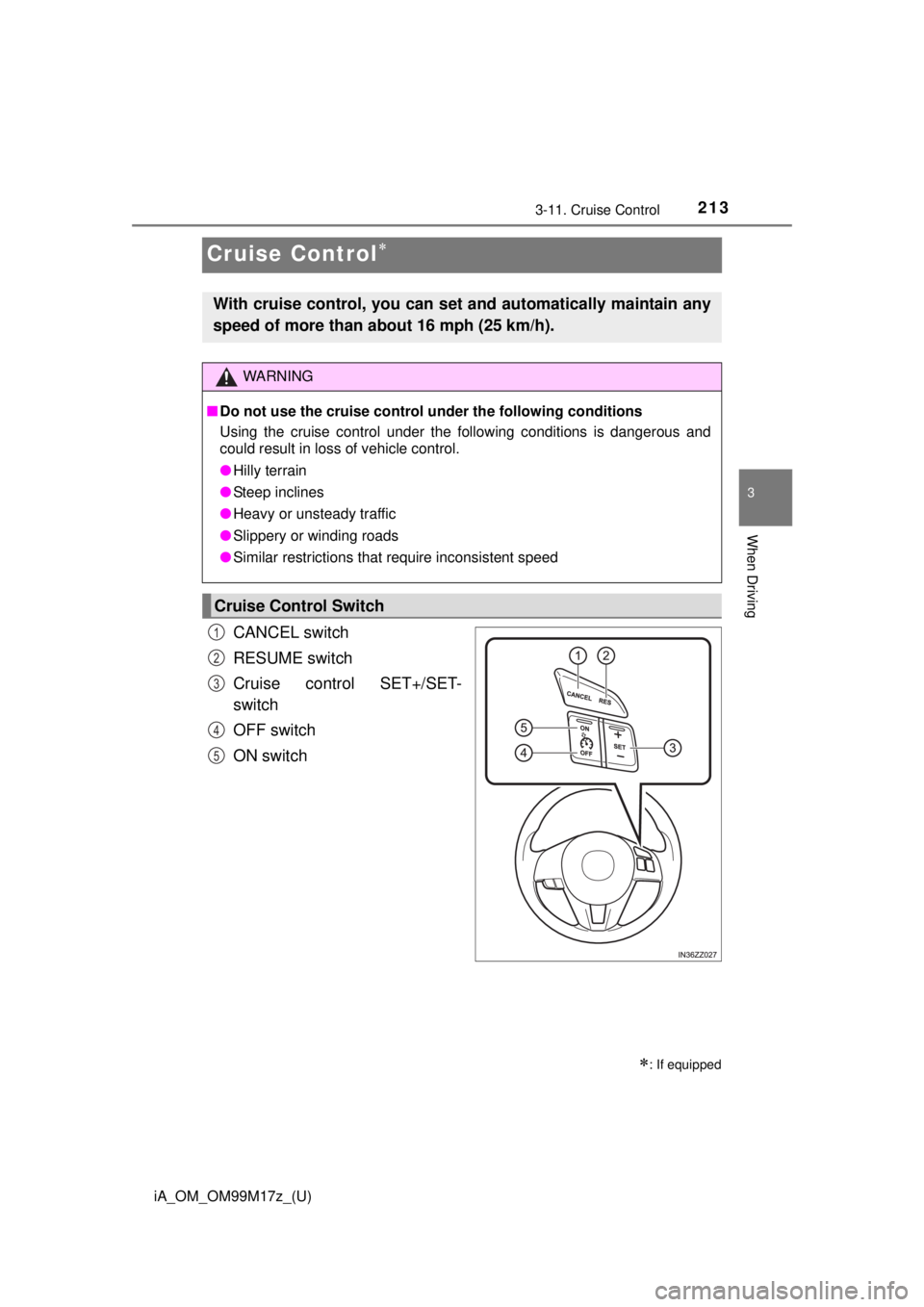
213
iA_OM_OM99M17z_(U)
3-11. Cruise Control
3
When Driving
Cruise Control
CANCEL switch
RESUME switch
Cruise control SET+/SET-
switch
OFF switch
ON switch
: If equipped
With cruise control, you can set and automatically maintain any
speed of more than about 16 mph (25 km/h).
WARNING
■Do not use the cruise control under the following conditions
Using the cruise control under the following conditions is dangerous and
could result in loss of vehicle control.
● Hilly terrain
● Steep inclines
● Heavy or unsteady traffic
● Slippery or winding roads
● Similar restrictions that require inconsistent speed
Cruise Control Switch
1
2
3
4
5
Page 214 of 588
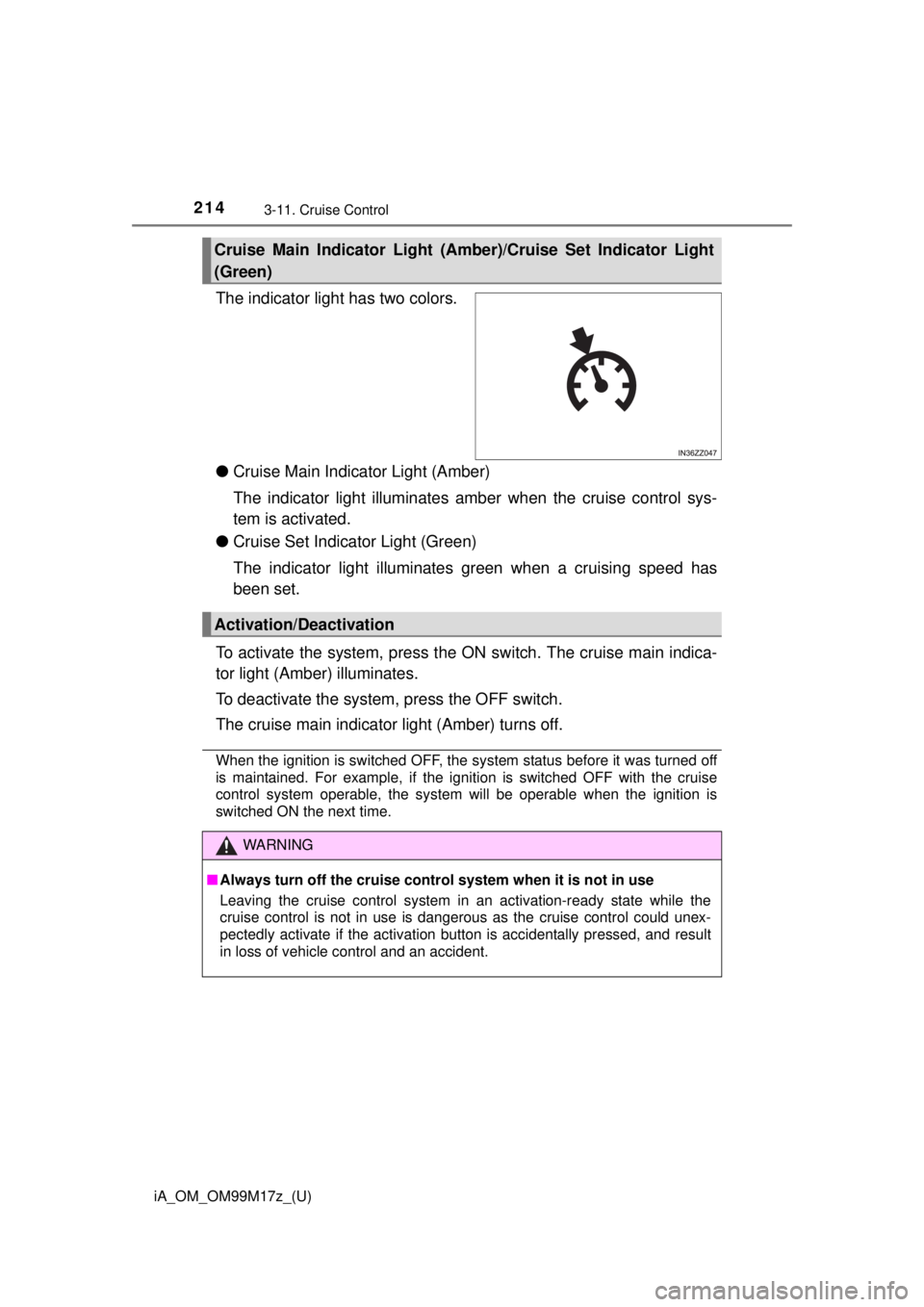
214
iA_OM_OM99M17z_(U)
3-11. Cruise Control
The indicator light has two colors.
●Cruise Main Indicator Light (Amber)
The indicator light illuminates amber when the cruise control sys-
tem is activated.
● Cruise Set Indicator Light (Green)
The indicator light illuminates green when a cruising speed has
been set.
To activate the system, press the ON switch. The cruise main indica-
tor light (Amber) illuminates.
To deactivate the system, press the OFF switch.
The cruise main indicator light (Amber) turns off.
When the ignition is switched OFF, the system status before it was turned off
is maintained. For example, if the ignition is switched OFF with the cruise
control system operable, the system will be operable when the ignition is
switched ON the next time.
Cruise Main Indicator Light (Amber)/Cruise Set Indicator Light
(Green)
Activation/Deactivation
WARNING
■ Always turn off the cruise control system when it is not in use
Leaving the cruise control system in an activation-ready state while the
cruise control is not in use is dangerous as the cruise control could unex-
pectedly activate if the activation button is accidentally pressed, and result
in loss of vehicle control and an accident.
Page 215 of 588

iA_OM_OM99M17z_(U)
2153-11. Cruise Control
3
When Driving
Activate the cruise control system by pressing the ON switch. The
cruise main indicator light (Amber) illuminates.
Accelerate to the desired speed, which must be more than 16 mph
(25 km/h).
Set the cruise control by pressing the SET or SET switch at
the desired speed. The cruise control is set at the moment the SET
or SET switch is pressed. Release the accelerator pedal
simultaneously. The cruise set indi cator light (Green) illuminates.
●The cruise control speed setting cannot be performed under the following
conditions:
• Manual transaxle: The shift lever is in the neutral position.
• Automatic transaxle: The selector lever is in the P or N position.
• The parking brake is applied.
● Release the SET or SET switch at the desired speed, otherwise the
speed will continue increasing while the SET switch is pressed and held,
and continue decreasing while the SET switch is pressed and held
(except when the accelerator pedal is depressed).
● On a steep grade, the vehicle may momentarily slow down while ascending,
or speed up while descending.
● Cruise control will cancel if the vehicle speed decreases below 13 mph (21
km/h) when cruise is activated, such as when climbing a steep grade.
● Cruise control may cancel at about 9 mph (15 km/h) below the preset
speed, such as when climbing a long, steep grade.
To S e t S p e e d
1
2
3
Page 216 of 588
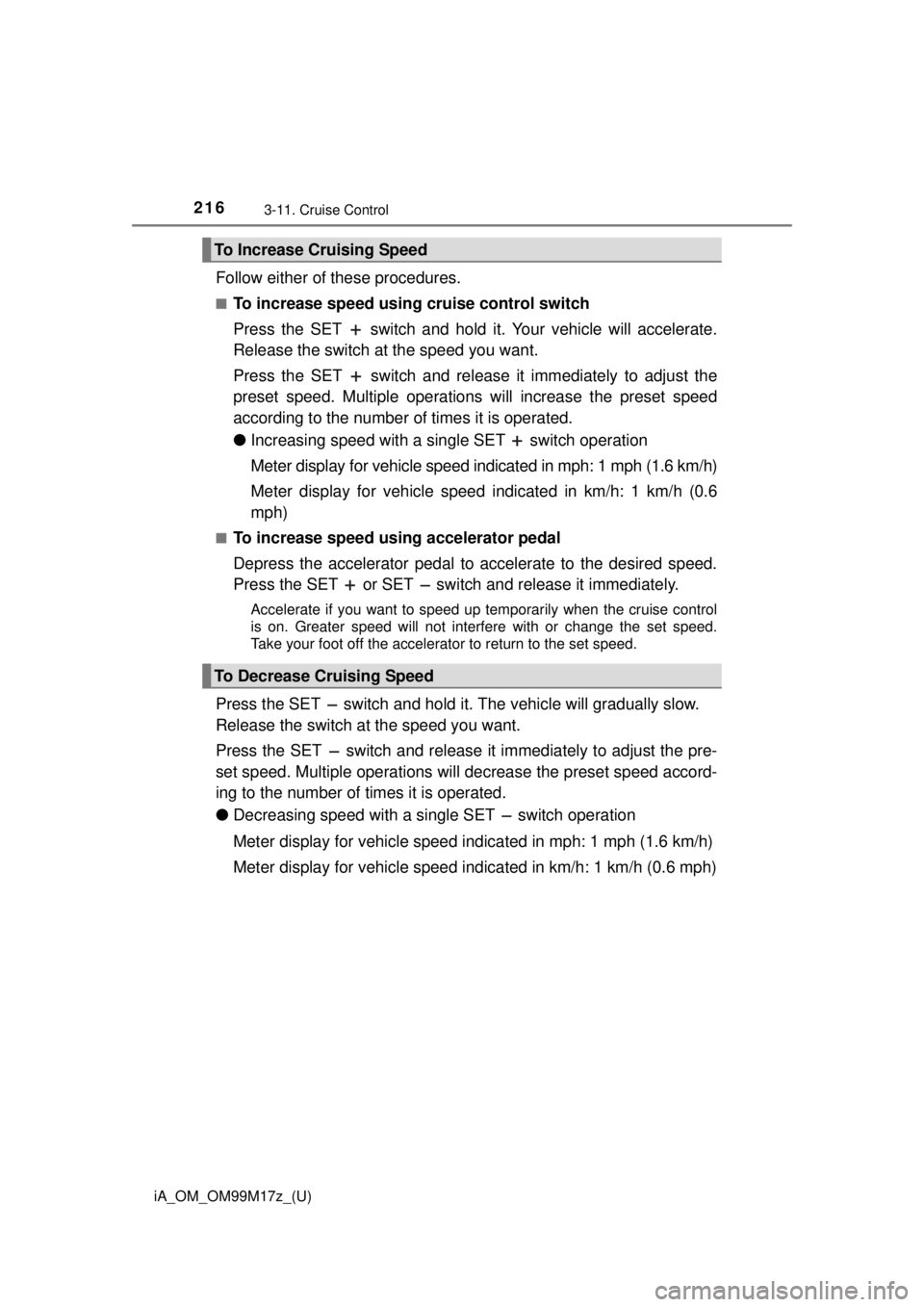
216
iA_OM_OM99M17z_(U)
3-11. Cruise Control
Follow either of these procedures.
■To increase speed using cruise control switch
Press the SET switch and hold it. Your vehicle will accelerate.
Release the switch at the speed you want.
Press the SET switch and release it immediately to adjust the
preset speed. Multiple operations will increase the preset speed
according to the number of times it is operated.
● Increasing speed with a single SET switch operation
Meter display for vehicle speed indicated in mph: 1 mph (1.6 km/h)
Meter display for vehicle speed indicated in km/h: 1 km/h (0.6
mph)
■To increase speed using accelerator pedal
Depress the accelerator pedal to accelerate to the desired speed.
Press the SET or SET switch and release it immediately.
Accelerate if you want to speed up temporarily when the cruise control
is on. Greater speed will not interfere with or change the set speed.
Take your foot off the accelerator to return to the set speed.
Press the SET switch and hold it . The vehicle will gradually slow.
Release the switch at the speed you want.
Press the SET switch and release it immediately to adjust the pre-
set speed. Multiple oper ations will decrease the preset speed accord-
ing to the number of times it is operated.
● Decreasing speed with a single SET switch operation
Meter display for vehicle speed indicated in mph: 1 mph (1.6 km/h)
Meter display for vehicle speed indicated in km/h: 1 km/h (0.6 mph)
To Increase Cruising Speed
To Decrease Cruising Speed
Page 217 of 588
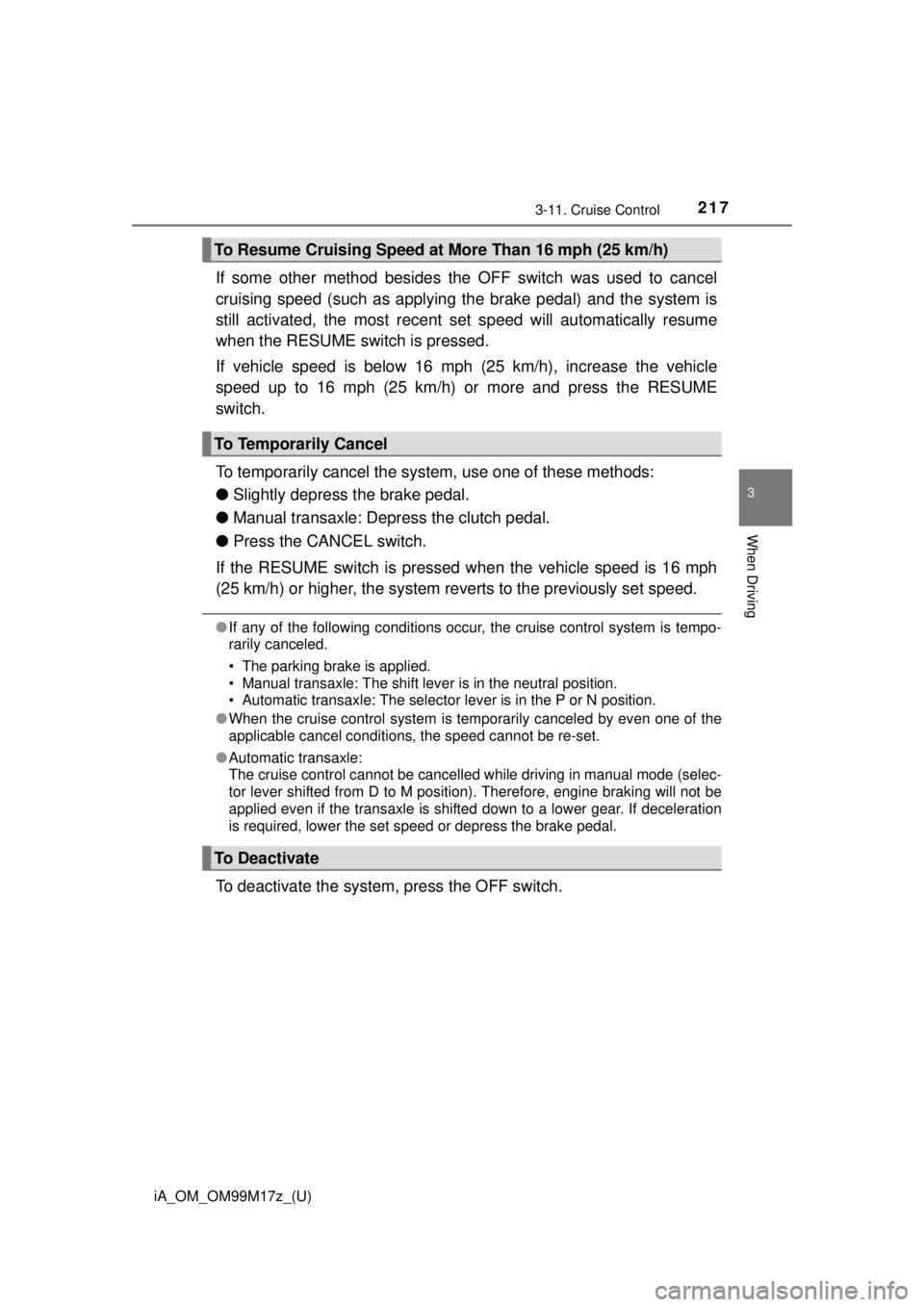
iA_OM_OM99M17z_(U)
2173-11. Cruise Control
3
When Driving
If some other method besides the OFF switch was used to cancel
cruising speed (such as applying the brake pedal) and the system is
still activated, the most recent set speed will automatically resume
when the RESUME switch is pressed.
If vehicle speed is below 16 mph (25 km/h), increase the vehicle
speed up to 16 mph (25 km/h) or more and press the RESUME
switch.
To temporarily cancel the syst em, use one of these methods:
● Slightly depress the brake pedal.
● Manual transaxle: Depress the clutch pedal.
● Press the CANCEL switch.
If the RESUME switch is pressed when the vehicle speed is 16 mph
(25 km/h) or higher, the system re verts to the previously set speed.
●If any of the following conditions occur, the cruise control system is tempo-
rarily canceled.
• The parking brake is applied.
• Manual transaxle: The shift lever is in the neutral position.
• Automatic transaxle: The selector lever is in the P or N position.
● When the cruise control system is temporarily canceled by even one of the
applicable cancel conditions, the speed cannot be re-set.
● Automatic transaxle:
The cruise control cannot be cancelled while driving in manual mode (selec-
tor lever shifted from D to M position). Therefore, engine braking will not be
applied even if the transaxle is shifted down to a lower gear. If deceleration
is required, lower the set speed or depress the brake pedal.
To deactivate the system, press the OFF switch.
To Resume Cruising Speed at More Than 16 mph (25 km/h)
To Temporarily Cancel
To Deactivate
Page 218 of 588
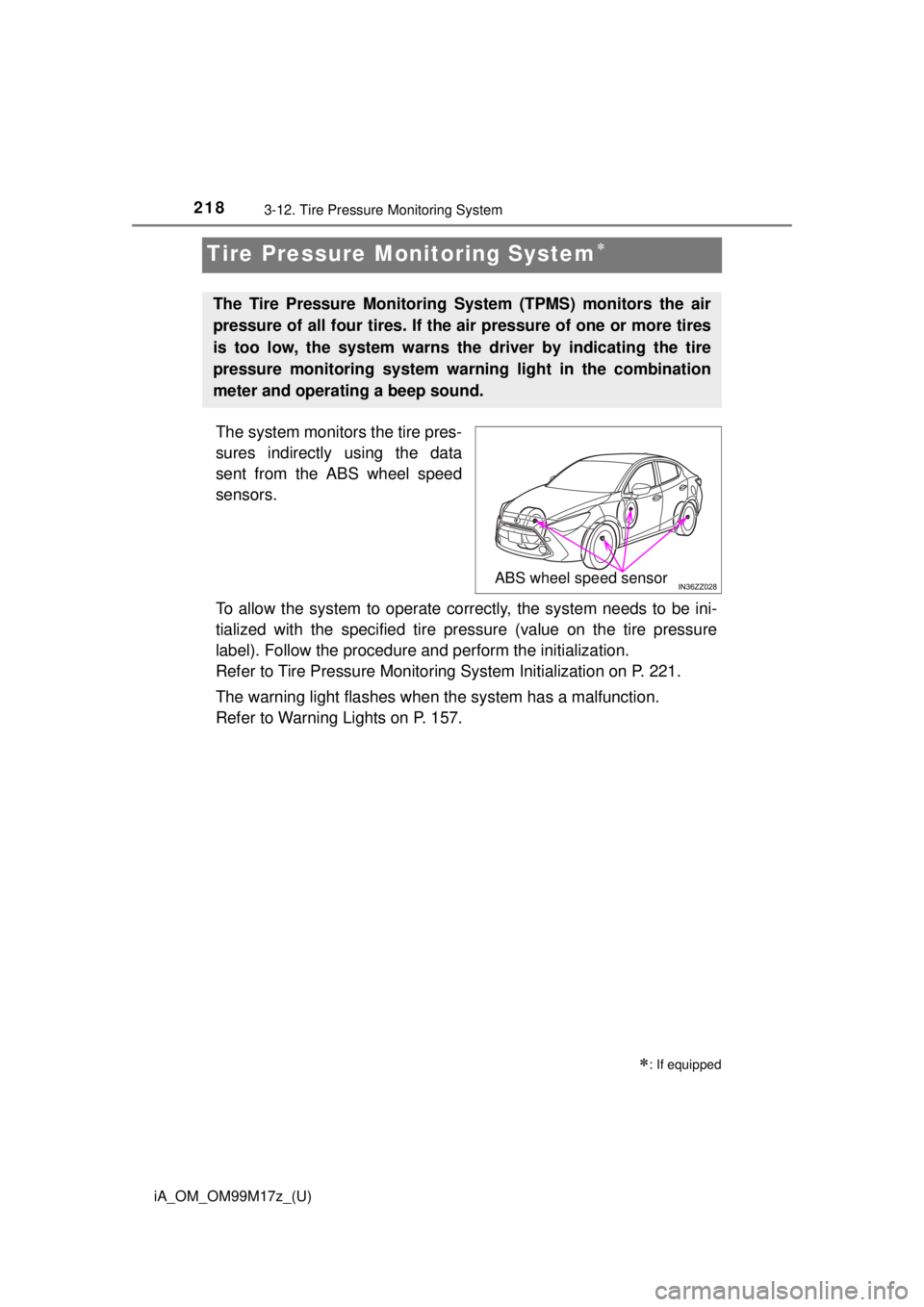
218
iA_OM_OM99M17z_(U)
3-12. Tire Pressure Monitoring System
Tire Pressure Monitoring System
The system monitors the tire pres-
sures indirectly using the data
sent from the ABS wheel speed
sensors.
To allow the system to operate correctly, the system needs to be ini-
tialized with the specified tire pressure (value on the tire pressure
label). Follow the procedure and perform the initialization.
Refer to Tire Pressure Monitoring System Initialization on P. 221.
The warning light flashes when the system has a malfunction.
Refer to Warning Lights on P. 157.
: If equipped
The Tire Pressure Monitoring System (TPMS) monitors the air
pressure of all four tires. If the air pressure of one or more tires
is too low, the system warns the driver by indicating the tire
pressure monitoring system warning light in the combination
meter and operating a beep sound.
ABS wheel speed sensor
Page 219 of 588

iA_OM_OM99M17z_(U)
2193-12. Tire Pressure Monitoring System
3
When Driving
Because this system detects slight changes in tire conditions, the timing
of the warning may be faster or slower in the following cases:
●The size, manufacturer, or the type of tires is different from the specifica-
tion.
●The size, manufacturer, or the type of a tire is different from the others,
or the level of tire wear is excessively different between them.
●A run-flat tire, studless tire, snow tire, or tire chains are used.
●An emergency tire is used (The tire pressure monitoring system warning
light may flash and then continue illuminating).
●A tire is repaired using the emergency flat tire repair kit.
●The tire pressure is excessively hi gher than the specified pressure, or
the tire pressure is suddenly lowered for some reason such as a tire
burst during driving.
●The vehicle speed is lower than about 9.3 mph (15 km/h) (including
when the vehicle is stopped), or t he drive period is shorter than 5 min-
utes.
●The vehicle is driven on an extremely rough road or a slippery, icy road.
●Hard steering and rapid acceleration/deceleration are repeated such as
during aggressive driving on a winding road.
●Load on the vehicle is applied to a tire such as by loading heavy luggage
to one side of the vehicle.
●System initialization has not been im plemented with the specified tire
pressure.
Page 220 of 588

220
iA_OM_OM99M17z_(U)
3-12. Tire Pressure Monitoring System
NOTICE
●Each tire, including the spare (if provided), should be checked monthly
when cold and inflated to the inflation pressure recommended by the
vehicle manufacturer on the vehicle placard or tire inflation pressure
label. (If your vehicle has tires of a different size than the size indicated
on the vehicle placard or tire inflation pressure label, you should deter-
mine the proper tire inflation pressure for those tires.)
As an added safety feature, your vehicle has been equipped with a tire
pressure monitoring system (TPMS) that illuminates a low tire pres-
sure telltale when one or more of your tires is significantly under-
inflated. Accordingly, when the low tire pressure telltale illuminates,
you should stop and check your tires as soon as possible, and inflate
them to the proper pressure. Driving on a significantly under-inflated
tire causes the tire to overheat and can lead to tire failure. Under-infla-
tion also reduces fuel efficiency and tire tread life, and may affect the
vehicle’s handling and stopping ability.
Please note that the TPMS is not a substitute for proper tire mainte-
nance, and it is the driv er’s responsibility to main tain correct tire pres-
sure, even if under-inflation has not reached the level to trigger
illumination of the TPMS lo w tire pressure telltale.
Your vehicle has also been equipped with a TPMS malfunction indica-
tor to indicate when the system is not operating properly.
The TPMS malfunction indicator is combined with the low tire pressure
telltale. When the system detects a malfunction, the telltale will flash
for approximately one minute and then remain continuously illumi-
nated. This sequence will continue upon subse quent vehicle start-ups
as long as the malfunction exists . When the malfunction indicator is
illuminated, the system ma y not be able to detect or signal low tire
pressure as intended. TPMS malfunctions may occur for a variety of
reasons, including the installation of replacement or alternate tires or
wheels on the vehicle that prevent the TPMS from functioning properly.
Always check the TPMS malfunction telltale after replacing one or
more tires or wheels on your vehi cle to ensure that the replacement or
alternate tires and wheels allow the TPMS to continue to function prop-
erly.
●To avoid false readings, the system samples for a little while before
indicating a problem. As a result it will not instantaneously register a
rapid tire deflation or blow out.